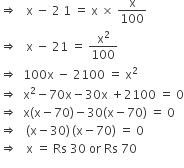 Multiple Choice Questions
Multiple Choice QuestionsWhen the price of a toy was increased by 20%, the number of toys sold was decreased by 15%. What was its effect on the total sales of the shop?
2% increase
2% decrease
4% increase
4% increase
A person sold a horse at a gain of 15%. Had he bought it for 25% less and sold it for Rs. 60 less, he would have made a profit of 32%. The cost price of the horse was
Rs. 370
Rs. 372
Rs. 375
Rs. 375
A sells an article to B at a gain of 25% B sells it to C at a gain of 20% and C sells it to D at a gain of 10%. If D pays Rs. 300 for it, how much did it cost to A?
Rs. 200
Rs. 250
Rs. 275
Rs. 275
By selling an article for Rs. 21, a man lost such that the percentage loss was equal to the cost price. The cost price of the article was
Rs. 30 or Rs. 70
Rs. 35 or Rs. 60
Rs. 45
Rs. 45
A.
Rs. 30 or Rs. 70
Let the C.P. of article be Rs. x
C.P. - S.P = Loss
Half of 100 articles were sold at a profit of 20% and the rest at a profit of 40%. If all the articles had been sold at a profit of 25%, the total profit would have been Rs. 100 less than earlier profit. The cost price of each article was
Rs. 10
Rs. 15
Rs. 20
Rs. 20
The marked price of a clock is Rs. 3200. It is to be sold at Rs. 2448 at two successive discounts. If the first discount is 10%, then the second discount is
5%
10%
15%
15%
A dealer marks his goods 30% above his cost price and then allows 15% discount on it. What is the cost price of an article on which he gains Rs. 84?
Rs. 800
Rs. 560
Rs. 373.33
Rs. 373.33
A shopkeeper wishes to give 5% commission on the marked price of an article but also wants to earn a profit of 10%. If his cost price is Rs. 95, then the marked price is
Rs. 100
Rs. 110
Rs. 120
Rs. 120
Krishnamurthy earns Rs. 15000 per month and spends 80% of it. Due to pay revision, his monthly income has increased by 20%, but due to price rise, he has to spend 20% more. His new savings are
Rs. 3400
Rs. 3000
Rs. 3600
Rs. 3600
Two numbers are respectively  and 25% more than a third number. The first number is how much per cent of the second number?
and 25% more than a third number. The first number is how much per cent of the second number?
90
87.5
25
25
